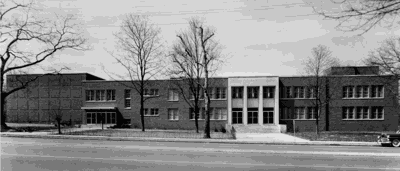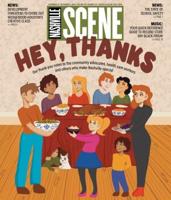
Jewish Community Center, Nashville, 1951
This week marks the 60th Anniversary of the somewhat unsolved bombing of the Jewish Community Center on March 16, 1958. That evening at 8:07 p.m. the building, which then sat at 3500 West End Avenue, had its front entrance damaged and windows on neighboring houses were blown out. No one was injured.
Details of the incident and the subsequent investigation into it can still be found in old newspaper clips and FBI records.
This bomb was much smaller than the bomb that blew up Hattie Cotton Elementary School the previous fall. Damage to the JCC was mostly cosmetic. Also, this bomb had a lit fuse, unlike the Hattie Cotton bomb, which was detonated by electric charge. The FBI recorded that the explosive was placed near the door in such a way that indicated that the bomber could have used the building’s shrubbery for cover while coming and going. The FBI said that the Nashville Police Department and the Tennessee Bureau of Criminal Identification found two pieces of Orange Wax Clover Safety Fuse about five feet long and “taped together with light-colored masking tape, which was approximately three quarters of an inch in width.”
Rabbi Silverman of The Temple out in Belle Meade received a call before he had even heard the news of the explosion. His wife answered the phone and according to The Tennessean and the FBI, the caller said, “I am a member of the Confederate Union. We have just dynamited the Jewish Community Center. Next will be The Temple, and next will be any other nigger-loving place or nigger-loving person in Nashville. And we’re going to shoot down Judge Miller in cold blood.” Judge William Miller was the judge overseeing Nashville’s school integration.
A few minutes later, a man called The Tennessean and said, “This is the Confederate Underground. We just blew up the center of the integrationists in Nashville. Now we are going after Judge Miller.” An hour later, an anonymous caller reached the United Press and said “This is the Confederate Underground. We have just blown up the integration center. Our next target is Judge Miller. We are going to shoot him down in the street. The dirty son of a bitch.”
As we, as a city, have recounted this story, when we do bother to recount it, we often fail to link it explicitly to school integration. But we should note that the bomber or bombers did.
This is, in part, because two of the prominent racist activists who were often in town during this time — John Kasper and J.B. Stoner — were virulent anti-Semites.
While there had been a rise in anti-Jewish terrorism in the late ‘50s, until the Confederate Underground started taking credit for bombings, officials were slow to link it to integration. In part, this was because southern segregationists weren’t uniformly anti-Jewish. A North Carolina Klan, for instance, was opposed to John Kasper coming to that state because of his attitude toward Jewish people. This seems strange now in an era when racism and anti-Semitism go hand-in-hand. But back then, when the men who were of an age to be leaders in the Klan were, by and large, World War II veterans who saw themselves as patriots fighting to preserve a distinctly American way of life, they were wary of anything that smelled too much like Nazism — the thing they had fought and watched their friends die to defeat.
So, an important rhetorical strategy of men like Stoner and Kasper was to link Jews to communism in the minds of racist whites. If Jews were communist, then opposing them wasn’t taking the side of the Nazis against America, it was taking the side of America against The Reds. Their theory was that black people were not smart or ambitious enough to want equality for themselves and were, normally, happy in their lot. It was the communist Jews who were putting ideas in black people’s heads, telling them they were unhappy, and planning and directing black protests behind the scenes. Black aspirations for equality, they said, were just a symptom of a Jewish communist plot to ruin America.
The papers reported that the JCC had been hosting integrated community meetings, though there hadn’t been one for weeks. According to Gilbert Fox, who was the vice-president of the JCC at the time of the bombing, there had been an integrated activity, though. The JCC youth basketball team had recently hosted a black youth community basketball team. (Just as a side note: the late Perry Wallace, who integrated Vanderbilt’s basketball team in the 1960s worked a couple of summers as a counselor at the JCC, which means that, even in the wake of believing the presence of black basketball players had gotten them bombed, the JCC remained open and welcoming to black basketball players.)
Fox, and other Jewish leaders, suspected that electricians who had been in the building that week had seen the children playing together and either they were the bombers or they had alerted the bombers to the situation.
But it’s likely that, even without this precipitating event, the JCC would have been bombed. Jewish community centers, temples, and synagogues throughout the South — in cities J.B. Stoner was familiar with — were bombed during this time. And J.B. Stoner was familiar with Nashville.
By the end of 1958, the Anti-Defamation League had a pretty clear theory of the bombing, which they recognized as being a part of a region-wide wave of terrorism. On November 11, 1957, there was an attempted bombing at the Temple Beth El in Charlotte, North Carolina; on February 9, 1958, there was an attempted bombing at the Temple Emanuel in Gastonia, North Carolina, The Beth-El temple in Miami was bombed the same day as our JCC, on April 27, a black high school and a Jewish synagogue were bombed in Jacksonville, Florida, and the next day, April 28, The Temple Beth El in Birmingham, Alabama, had a bombing attempt; and then on October 12, the Temple in Atlanta was blown up.
The Confederate Underground claimed responsibility by phone in many of these bombings. In the case of the Jacksonville bombing, the caller said, “This is the Confederate Underground. We’ve just blown up the Jacksonville Jewish Center of Integration.” The same language the caller here had used.
The ADL reported:
With regard to the bombings of Jewish institutions as such, several patterns seem to emerge. In all cases, an apparent attempt was made to avoid causing injury to human life, to time the explosions in such a way that they would only cause physical damage to property—with the evident intention of intimidating the Jewish communities.Almost identical shopping bags were used to conceal the dynamite in Gastonia and Birmingham. It also appears that in all cases with the possible exception of Birmingham, the dynamite employed was of a common variety readily purchasable or easily stolen.
In Nashville, Miami, Jacksonville and Atlanta, telephone calls were placed to prominent individuals by anonymous persons identifying themselves as members of the “Confederate Underground.” In each case the caller indicated a familiarity with what had transpired before it became a matter of public knowledge. Finally, it is generally believed by police and other experts that one group of individuals is responsible for all of the bombings against Jewish institutions.
You’d think that a criminal conspiracy that cut across state lines would be right up the FBI’s alley, but no. The Tennessean reported that the FBI was still convinced that “it lacks authority to enter the cases.”
The FBI, however, had heard from one informant that the Confederate Underground was J. B. Stoner and a small group of his friends and they heard from another informant that “JESSE B. STONER, now of Atlanta, Georgia, and his associates were responsible for the bombings in Jacksonville, Florida, on April 28, 1958.” The bombings where the caller who took responsibility for it used that same “Center of Integration” terminology as the caller here had used.
It’s not clear that the FBI ever informed Nashville (or any of the other cities) of the connections between the bombings. The FBI was still insisting that bombings were a state-level problem and that, while they should know about them, they were not obliged to investigate them. The local and state investigators didn’t have good ways to participate in the investigation of a multi-state bombing spree. Heck, even some states didn’t have good ways of sharing information between cities. In Florida, for example, there was no state level organization to help Miami and Jacksonville share information and coordinate their investigations. So, Miami may have had information we needed. We may have known something that would have helped Atlanta. But with the FBI refusing to be the entity that could see the whole picture, each location with a bombing was hamstrung.
Still, of the three integration-era bombings in Nashville, we have the most complete understanding of why and how this happened. Someone here did this at the behest of J.B. Stoner. That much looks certain. Who exactly, though, remains a mystery.





